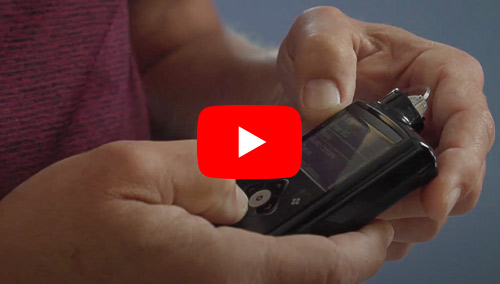As Participants and Providers, We’re Pioneers in Diabetes Research
May 09, 2023
 University Hospitals Rainbow Babies & Children'sExperts in Children's Health
University Hospitals Rainbow Babies & Children'sExperts in Children's Health

Study celebrates 40 years of impact around the world
When Cindy Catalano was diagnosed with type 1 diabetes at the age of 15, she was forced to grow up in ways she never imagined. With no other choice, she calculated her own medication needs with urine test strips and injected herself with insulin twice a day. She relied on how she felt – not on monitors or alarms – to know if her glucose levels dropped dangerously low. And all the while, she knew her future was uncertain.
That was the 1970s.
Nine years later, Cindy again saw her life change in unexpected ways when she joined what would become a groundbreaking study coordinated by UH Rainbow Babies & Children’s Hospital and carried out across 27 other clinical sites in the U.S. and Canada. It was a study that would revolutionize the understanding, care and treatment of type 1 diabetes (T1D) for millions of people.
“My mother found an ad in the newspaper looking for people with T1D to join a clinical trial,” Cindy recalls. “I had always taken care of diabetes on my own – it was just a way of life and the only way to survive – but I was beginning to gain weight and feel less in control. Joining the study was the best thing that ever happened to me.”
Revolutionary Results

Watch now: Rose Gubitosi-Klug, MD, PhD, chief of pediatric endocrinology & diabetes at UH Rainbow and EDIC’s current principal investigator, joins three trial participants to share what was learned from the trial and how it has transformed the management of type 1 diabetes for patients around the world.
The study in which Cindy participated was the National Institutes of Health’s Diabetes Control and Complications Trial (DCCT), which began in 1983 to find better ways of managing T1D. Specifically, it sought to determine if intensive management of diabetes involving multiple injections of insulin each day was better than the standard practice of two daily shots in balancing blood glucose levels and reducing complications. At the time, high rates of complications, ranging from eyesight and nerve damage to shorter lifespan, plagued people with type 1 diabetes. In fact, most people with T1D did not expect to live to older adulthood.
After 10 years, the study ended early because the findings were clear: keeping blood glucose levels more balanced with intensive management resulted in vastly better outcomes and lower complication rates.
“This finding was the spark that drove everything else in diabetes research,” says Rose Gubitosi-Klug, MD, PhD, chief of the Division of Pediatric Endocrinology, Diabetes & Metabolism at UH Rainbow Babies & Children’s. “It changed how all patients with T1D were treated and ignited a pharmaceutical and technological revolution in diabetes management.”
Changing History
After this landmark discovery, the DCCT evolved into the Epidemiology of Diabetes Interventions and Complications (EDIC) study. The DCCT/EDIC study continued to follow original DCCT participants to learn how diabetes affects the body over time and how to better care for them. Cindy was glad to continue as well.
The impact of information learned in the study has been immeasurable. A few advances that have occurred to improve and reduce the burden of intensive diabetes management include:
- More rapid-acting and easier-to-deliver types of insulin have been developed, resulting in greatly improved self-management.
- Continuous glucose monitors (CGM) have become commonplace, replacing finger sticks and urine testing.
- Insulin pumps were invented and evolved into small, personal and wearable devices that can communicate with CGMs to closely manage glucose levels.
Leading with Heart
Like Cindy, UH Rainbow Babies & Children’s has been at the heart of the DCCT/EDIC study since the very beginning. The hospital served as a DCCT clinical site, one where Cindy and other participants have gone for evaluation and testing for decades. The hospital has also functioned as the study-wide clinical coordinating center of the DCCT/EDIC study for the past 15 years, overseeing the initiative’s 27 testing sites in U.S. and Canada.
“The dedication to the DCCT/EDIC study is amazing – not only by participants, but also local study staff,” says Dr. Gubitosi-Klug. “One of our nurse research coordinators has been taking care of study participants since the very first day. Today, they are like family.”
Hope for the Future
This year the DCCT/EDIC study celebrates its 40th anniversary. The study recently received funding to continue for another five years. Currently, the study seeks to obtain more complete information on how diabetes affects brain health and physical fitness and the disease’s impact on other health outcomes and quality of life.
Cindy says she will continue to participate as long as the study is running.
“I feel like I’ve been a pioneer in diabetes research and am so grateful to be part of this study. Not only have I learned so much about how to take care of myself and have personally benefited from the advances in diabetes technology, but I know I have helped impact so many lives,” says Cindy. “My 16-year-old nephew Cameron was diagnosed with type 1 diabetes. What I’ve been through has helped make his future better, and now we work to help each other.”
Dr. Gubitosi-Klug adds, “A diagnosis of type 1 diabetes can be shocking. But in every family I meet that has been touched by the disease, this study brings them hope. These participants are living proof that if you manage your diabetes well, you can do anything you want in life.”


